The Ugly Truth About the Wild Animals of Instagram

Warning: Disturbing Content
Scrolling through Facebook one day in October 2017, wildlife photographer Melissa Groo seethed when she saw Heather Keepers had posted another image to Instagram of herself kissing a cougar, with the hashtags #coolestjobintheworld, #luckiestgirlintheworld.
More from Rolling Stone
A Private School Promised to Help Troubled Kids. Instead, Some Say, It Was a Nightmare
Fergie Chambers Is Heir to One of America's Richest Families - and Determined to See the U.S. Fall
Keepers, petite with long brown hair, blue-green eyes, and tattoos of constellations on her arms, was the face of an industry Groo despises: photography game farms, where captive exotic animals are kept to model for photo shoots. For nine years, Keepers was the head trainer at one of the nation’s top photography ranches, Triple D Wildlife in Kalispell, Montana.
Triple D’s animals have starred in films produced by National Geographic, Disney, Nature, and the BBC, according to the company’s website. They’ve also posed for calendars and ads, and they appear in countless Instagram posts. In a five-day workshop costing about $900, Triple D clients, ranging from professionals to amateurs and artists, can photograph more than a dozen animals, including grizzlies, cougars, bobcats, and wolves. Keepers trained the animals to leap over logs, stand perfectly still, and howl on cue. “You couldn’t have gotten these shots in the wild,” owner Jay Deist likes to tell his customers.
That’s exactly Groo’s point — such picture making is the antithesis of nature photography. She would know. Groo’s an acclaimed photographer and conservation advocate whose work has graced the covers of environmental magazines. Nearly six feet tall with long blond hair and usually toting a camera lens the size of a small howitzer, Groo is soft-spoken and deliberate. She will sit with her camera for hours at the edge of a pond patiently trying to capture not only an image of a great blue heron on the hunt for a fish, but also the bird’s very essence. For roughly a decade, she has worked to expose the deceptiveness of game-farm photography and advocated for ethical standards and transparency in publishing. “This business is polluting the whole landscape of wildlife photography,” Groo says. “They’re taking away from the work of authentic photographers.”
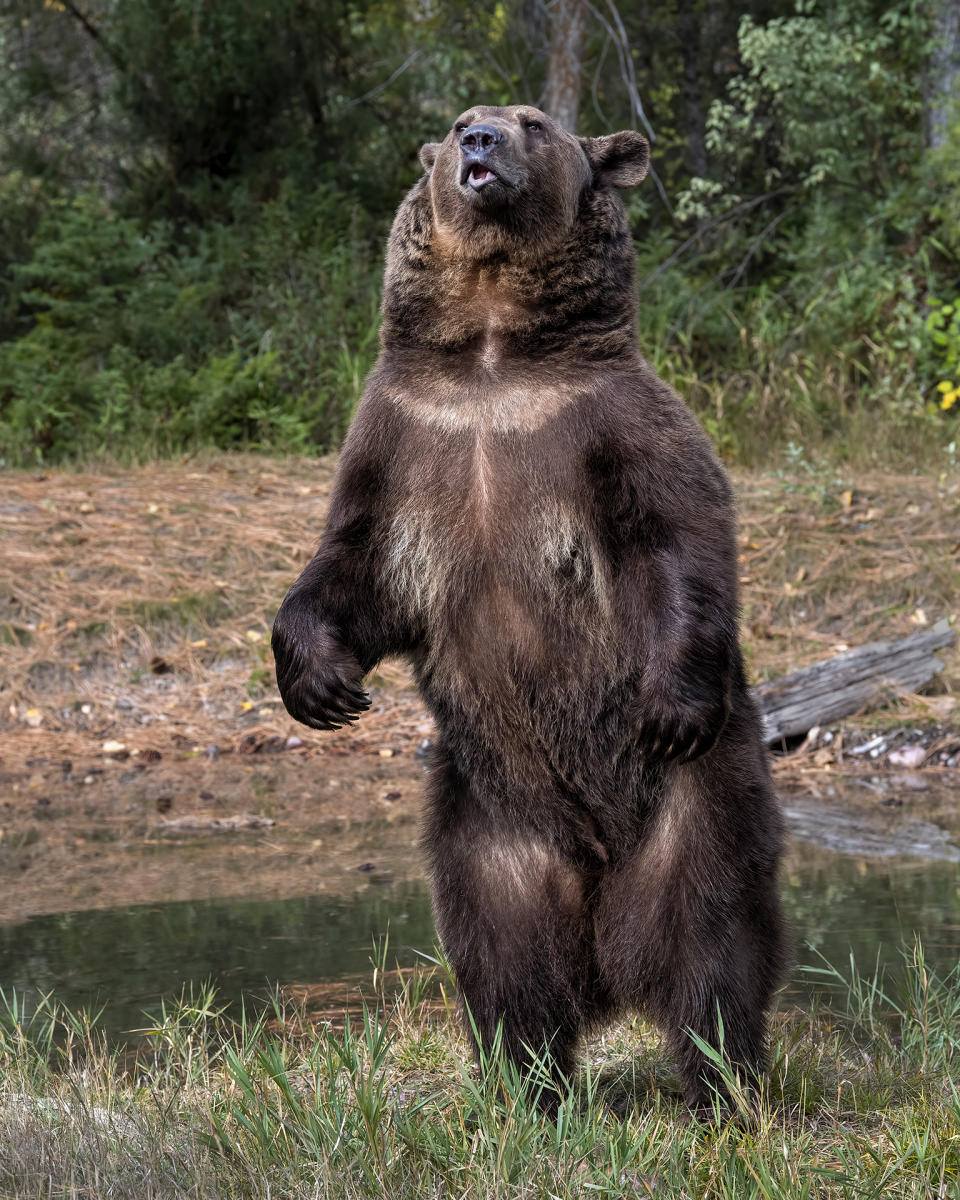
What’s more, she claims, there’s a “dirty secret” behind many of those cute animal images that show up on your Instagram feed. She alleges game farms’ animal models — including the ones at Triple D — are kept in small, filthy cages; some of the menagerie exist purely for breeding, supplying pups and kittens for popular baby-animal photography workshops; and once those babies have served their purpose, they’re regularly sold to exotic-pet buyers on the internet, or worse, to fur farms. “These despicable places breed and dump animals, like the exotic version of puppy mills,” Groo says.
Keepers, on the other hand, defended the farms and her work, saying they provided a rare up-close opportunity for people who aren’t physically or financially able to go on a safari or camping trips to photograph animals. She and Groo were often on opposite sides of the debate online, but they shared a love for animals.
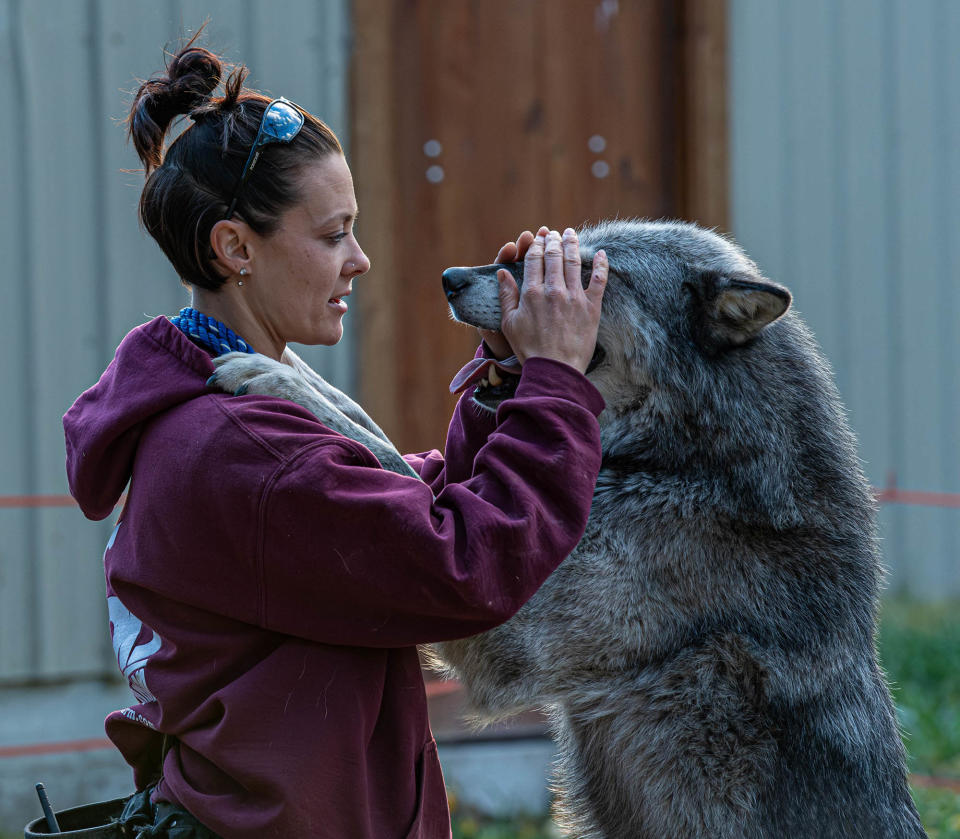
After college, Keepers took a zookeeping course at Cat Tales Wildlife Academy in Colbert, Washington, because she always dreamed of working with big cats and bears. She likes to give the wolves in her care nose kisses, admits she’d rather baby-talk to a 600-pound grizzly than put up with most humans, and keeps herself trim and fit enough to run alongside a tiger while training it with a treat.
For many years, Keepers defended Triple D’s business practices, and often sparred with Groo in the comments of her accusing Facebook posts. But something changed in the summer of 2020. Suddenly, Keepers stopped boasting about her #coolestjobintheworld.
On Aug. 27, she sent Groo a private message:
Hello Melissa. As I am not a big fan of yours, this message is difficult for me to send … While you and I are not friends, we do have a common enemy … for slightly different reasons, but also for many of the same. Triple D.
My time spent there was heaven and hell all wrapped in one. I loved those animals more than anyone could love anything. And I gave them the best I could with what I was provided with. I worked there for 9 years under the false pretense that I would soon be taking it over. I held onto that idea Bc I wanted to change so much of what it was. And is. Many things you are wrong about but many things you are right about.
I will not disclose any information to you yet. Other than I have ENDLESS information and evidence and knowledge of evidence of many things. Illegal, unethical, and just absolutely morally wrong and dishonest.
My goal in reaching out to you is simple. Those animals need to be “saved” from Jay Deist. Those animals deserve so much better. And especially now that I’m not there to provide half of what they deserve, a lot of them are now just sitting and rotting. Some have even died suddenly since I left.… I am obviously desperate to save them. And well … it’ll take someone who hates the Triple D as much as I do to do that. And I don’t mean some animals and then Jay can get more. I mean ALL animals. And his operation stops entirely. Forever.
Is this something that interests you?
Groo responded, “Absofuckinglutely.”
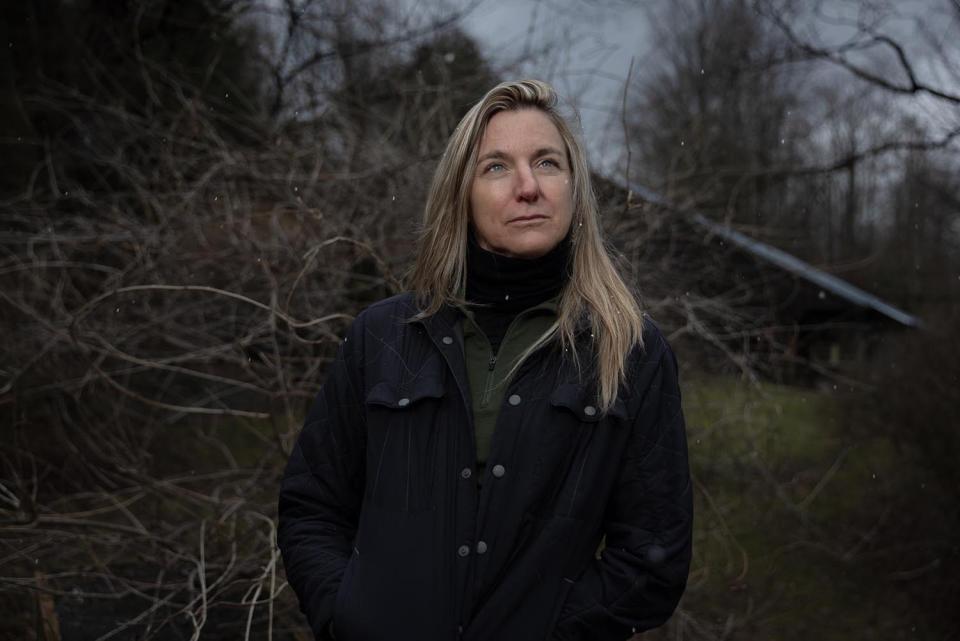
Both women and two additional former-employee whistleblowers would soon be slapped with lawsuits from Deist, who charges in ongoing litigation that they’ve damaged his business and wrecked his reputation. Deist declined multiple requests to be interviewed for this article and refused to answer a lengthy list of fact-checking questions, but in letters to his clients he maintains that his facility is a haven for wildlife that prides itself on the care and health of animals. “These wild, baseless allegations are false and reflect the complete lack of credibility in all of these former Triple D employees’ and associates’ social media statements about the Triple D facility,” says a letter from a law firm representing the Deists. “The Triple D is committed to its mission of providing excellence in animal care and welfare.”
“They’re trying to cover their butts,” says Keepers, who has been tracking animals — leopards, mountain lions, and a tiger — that she believes are being “offloaded” to animal sanctuaries, roadside zoos, and collectors because Triple D no longer has a place for them.
“They’re not animal lovers,” Keepers says of the Deists. “In their brains, they think they are, but they’re not.” To them, “animals don’t have emotions or souls — they’re just a commodity.”
You’ve seen the pictures — maybe you’ve even shared them with Instagram friends: A close-up of a wolf in the snow staring straight into the camera, a cougar leaping across a rocky chasm, a baby bobcat perched on a log framed with daisies. Many of those stunning animal images only simulate “wild.” The scenes are staged for customers paying for photo sessions with elusive animals that could take a photographer like Groo weeks, months, or even a lifetime to capture in the real wilderness. At game farms and off-site locations, trainers can get the wolves to howl or a cougar to leap on command with a scrap of raw meat.
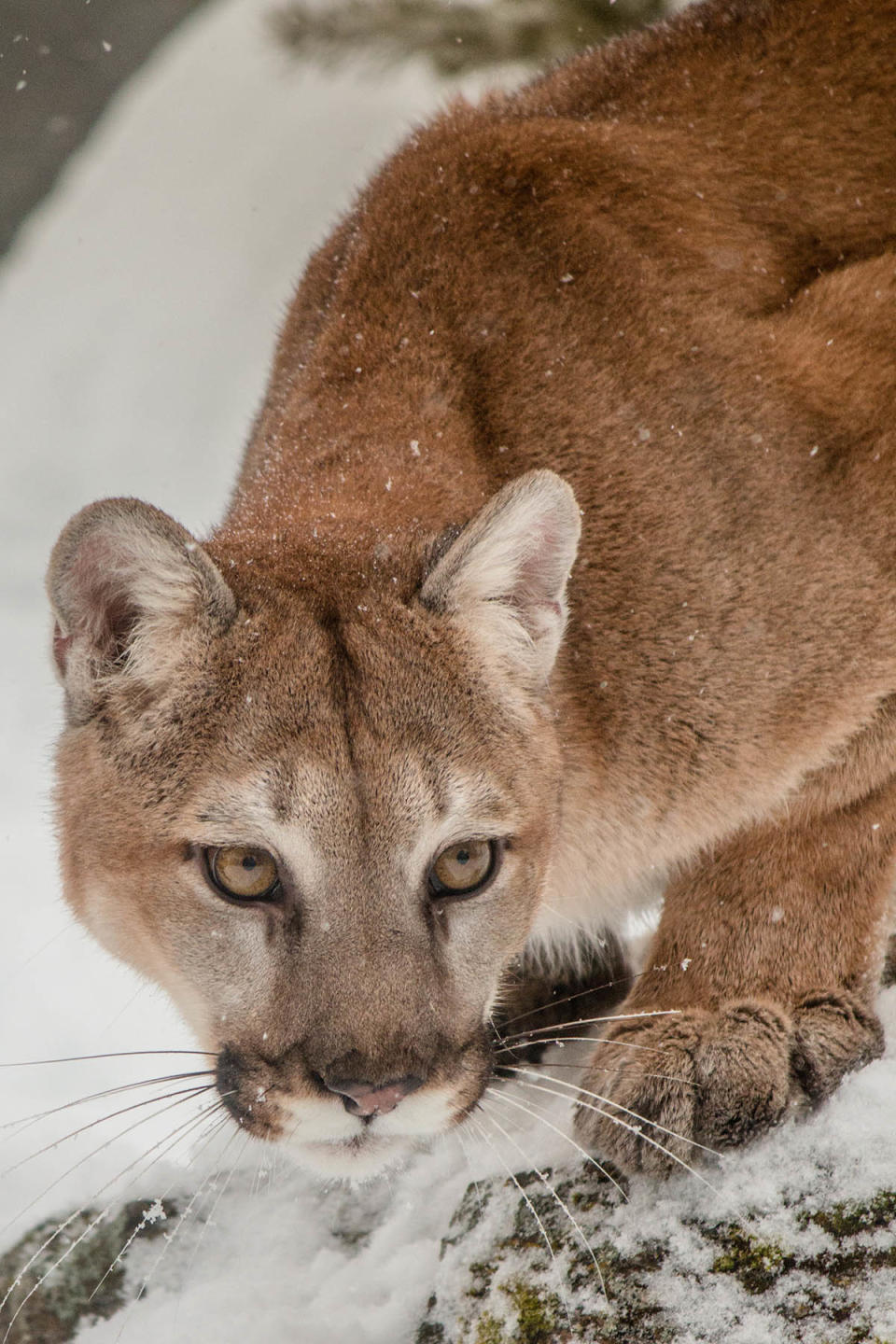
These animal photographs represent a multimillion-dollar business in stock photography and films. Photojournalist Chris Johns, who was National Geographic’s editor-in-chief from 2005 to 2014, says he knows photographers who made thousands selling game-farm-animal pictures, but adds the truly great photos don’t come from these shortcuts. Johns says no photographers should have any illusions about the industry or their role in it: “Make no mistake,” he says, by supporting places with questionable animal welfare, “you’re exploiting the animals.”
While the market isn’t as robust as it once was, today a crisp, large-scale bobcat picture still sells for nearly $500 on Getty Images’ website. Those stock pictures in turn appear in magazines, calendars, children’s books, and lucrative advertising campaigns. U.K. photographer David Yarrow’s 2015 photograph titled “The Wolf of Main Street,” featuring a wolf prowling a bar in Virginia City, Montana, reportedly sold at a Sotheby’s auction for $100,000.
Yarrow, who has taken a lot of heat for using game-farm animals in his past work, is quick to point out that film and TV have been much bigger supporters of the industry. Even some conservation organizations use game-farm photographs in their fundraising ads, says Groo — those images are cheap compared with assigning a photographer like her to take pictures in the wild. “I can’t imagine they don’t care,” she says. “I think they just don’t know. For me, it’s like putting an image of a trafficked sex slave on the cover of a women’s-rights magazine. It’s so wrong. Behind that glossy cover is an abject tale of an animal’s life of deprivation, living in filth in cramped quarters.”
In the wake of high-profile scandals, increased regulation, and shows like Tiger King, it seems only one photography game farm in the country has largely avoided bad publicity about wild-animal welfare: Triple D. It was founded over four decades ago by a former Montana state game warden, Lorney Deist, whose 1950s adventures hunting down mountain lions made newspapers, and his two sons — the three D’s. The D’s had planned to breed and likely sell Northwestern animals. But shortly after Triple D opened, a movie company contacted them wanting to film wolverines, and they wound up in the entertainment business instead.
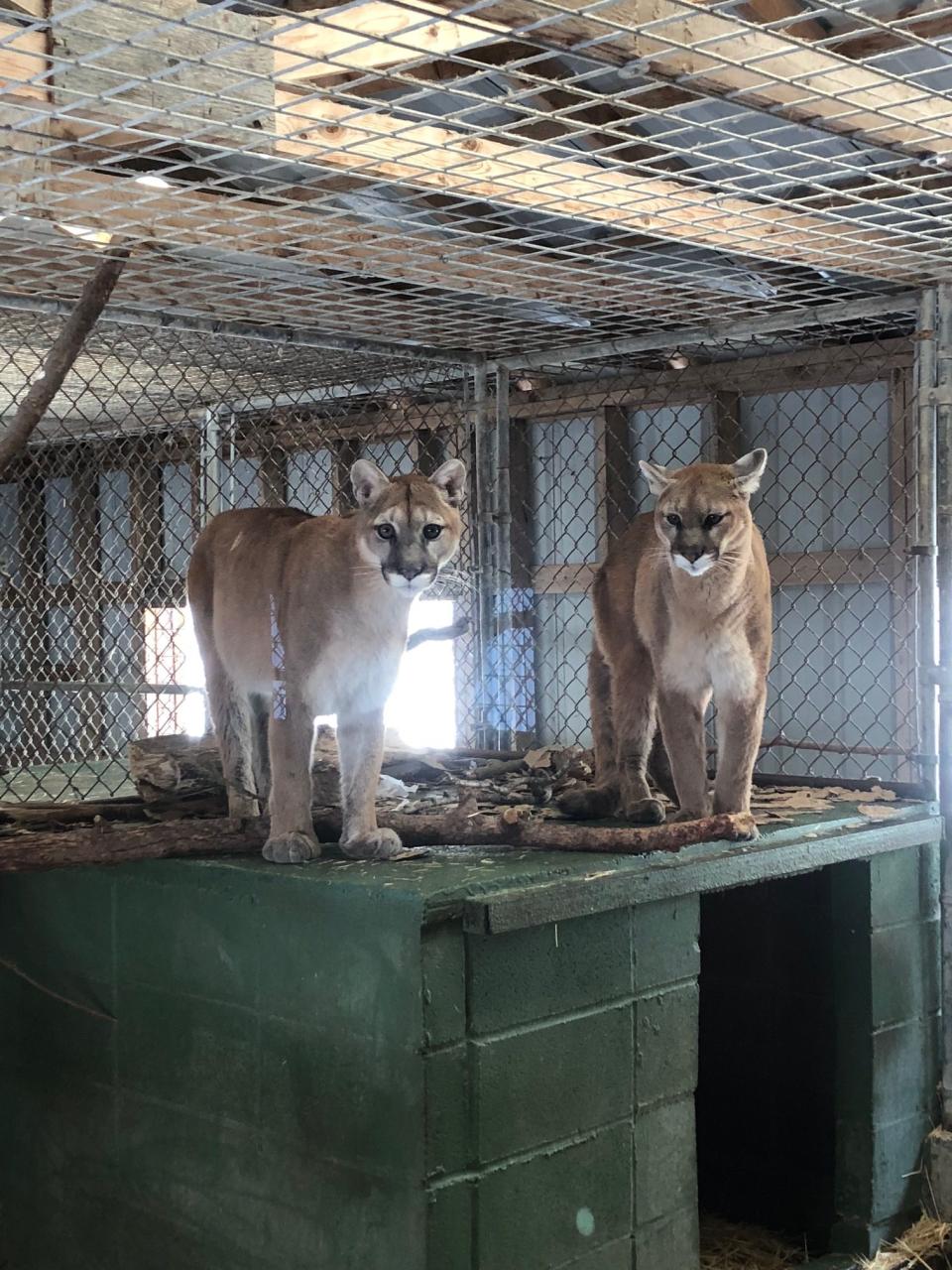
Today, Deist’s son Lorney, who goes by Jay, is the current owner of Triple D. With a silvery-white mane and a mustache, Jay, 77, and his second wife, Kim, 63, are both retired U.S. Forest Service law-enforcement agents. They promote the ranch as a place that “prides itself on the care and health of our animals, as well as preserving endangered species, so that they may be enjoyed by future generations.”
Some former employees describe the Deists as kind and generous people — the type of folks who would buy their workers Christmas presents and take them along on family vacations. Others say Jay’s sweet, fatherly persona masks a hot temper and intolerance for anyone who questions his authority.
Guests coming to the Deists’ 50-acre ranch, sandwiched between the Whitefish River and a suburban neighborhood of one- and two-story houses, most with pickup trucks in the driveways, enter the property through a log archway decorated with metal bear sculptures and the name “Triple D.”
Triple D features a roughly 1,100-square-foot home, rustic rental guest cabin, a shop and conference area containing one wall decorated with the skin of a six-year-old grizzly named BJ, and metal-roofed buildings filled with caged animals that include bobcats, mountain lions, wolves, and a bear named Bruno. “Magic” is how some clients posting on Triple D’s Facebook page describe their experience.
For a long time, Triple D “seemed above reproach,” Groo tells me. “Everyone who went there was like, ‘Their animals are so well-loved, and the trainer there, Heather, is so amazing with the animals. She loves them and takes such good care of them.’ Of course, no one was ever allowed to go see how the animals lived, and Heather was hiding these awful truths.”
Video of Triple D recorded by Heather Keepers in 2020 before she quit working at the game farm.
Groo discovered that the Deists had been cited by the U.S. Department of Agriculture in October 2013 for declawing a female tiger cub named Hershey when she was two months old. The practice of declawing big cats was banned by the USDA in 2006. Animal-welfare activists say it’s akin to an amputation surgery that involves removing the bone up to the first knuckle, causing acute and chronic pain that can result in the inability to do basic natural behaviors, including walking.
What’s more, Groo found a shocking document indicating that there had been concerns about animal welfare at Triple D dating back to 2003. The report, titled “Cruelty to Animals at the Triple D Game Farm,” was prepared by a private-investigation company called RSJM Enterprises. It includes statements from three former Triple D employees detailing a hidden animal-breeding area called “the Back 40” on the Deist compound, where they said animals were concealed from government inspectors. In emails enclosed in the report, one past employee said animals were being kept in squalid conditions. Another said animals born at Triple D were held until the following spring, when their “coats were in peak condition,” and then killed for their pelts to “make room” for more babies.
Groo couldn’t believe what she was reading. “The truth was worse than I had even imagined,” she says. “I felt absolute horror. It made me more committed to educate people about game farms.”
I tried to track down the former employees who gave signed statements during the investigation. One woman, Susan Parodi (formerly McGee), agreed to talk. She says she doesn’t remember how long she worked at Triple D — maybe six months — but she does “remember vividly the things she saw.”
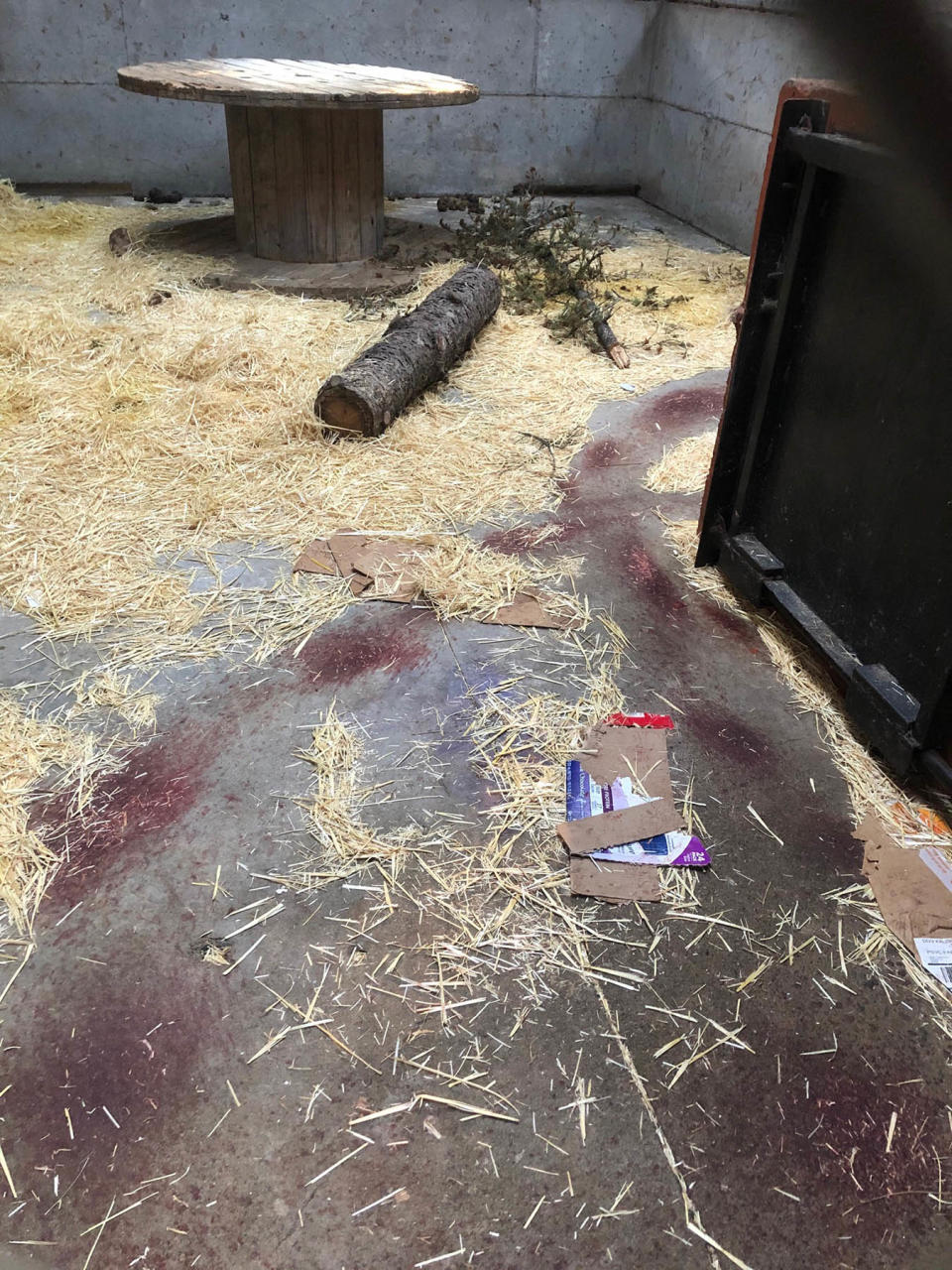
“The first thing I noticed was the conditions that some of the animals were living in,” Parodi says, alleging that many of the animals in the Back 40, a wooded area tucked away near the river’s edge, were in a collection of wire cages suspended on stilts. “No animal that has paws should be forced to walk on wire all day long with no support underneath,” she says. “That was really prevalent.” She remembers a bobcat whose foot had become infected from walking on the wire. She was putting antibiotic drops in the cat’s food, but she alleges that Deist told her to stop. “He told me I couldn’t keep wasting money giving the cat antibiotics to help heal her foot,” she says. “She ended up passing away.”
Parodi says the incident that made her quit involved a mountain lion named Anna, her two kittens, and another Triple D employee. She alleges that she was asked to hold one of the kittens as the employee went into the enclosure and removed the other from its mother. “Anna is screaming and crying, and he put the kitten out in the snow and shot it in the head,” she says. “To give it to a taxidermist.”
“That was it for me,” she says. “I was like, ‘OK, I’m done.’ ”
Parodi charges that when she told Deist why she was quitting, he said, “Oh, you know, animals die, and we have to cull the herd.”
When Deist learned that Rolling Stone had a copy of the RSJM report, his publicist sent us an email stating that the “report was the basis for a lawsuit in federal court that was dismissed decades ago as baseless.” The Deists, through their publicist, maintain that the report is “filled with false and malicious information.”
Parodi says she had to seek therapy for the nightmares she had about her short time at Triple D and would testify in court about her experience, if asked. No government action ever came of the accusations in the report, and for the next 18 years, Triple D’s USDA routine inspections — all conducted by the same agent — were nearly pristine. The only exception during that time frame was the illegal tiger declawing, for which Deist received an official warning, but suffered no fine or repercussions.
They’re not animal lovers. They think they are, but to them, animals don’t have emotions or souls — they’re a commodity.
Heather Keepers, who was involved in reporting the declawing to the USDA, tells me that in almost a decade working for Deist, she never personally witnessed animals being intentionally killed. However, she alleges, Deist tried to persuade her to shoot a deer that got injured while at a photo location. “His explanation was I needed to be able to shoot ‘my’ leopard, or whatever, if it got out or was attacking someone,” Keepers recounts. The Back 40 was no secret during her time at Triple D, she says, but she’s embarrassed that she put a good face on the conditions in which the animals lived. More than half, she says, “never left their pens — never saw outside.” They were kept in cages for no other purpose than to produce babies.
Keepers grew up in Arizona, the youngest of five children in a family where both parents were U.S. Marines. Even when she was in fourth grade, she dreamed of one day working with big predatory animals. Prior to joining the Triple D staff in 2011, she used her zookeeper education to land a job as a tiger trainer at New Jersey’s Six Flags, where tigers performed — running, leaping, climbing, swimming — in a big-stage cat show. “It was a multimillion-dollar facility with seven trainers for seven tigers,” Keepers tells me. But when Six Flags filed for bankruptcy, they cut the tiger show. Keepers, then 28, needed a new job, and Triple D was hiring.
Looking at Triple D’s website, she was wowed by the variety of animals and all of the gorgeous landscapes she remembers seeing in the pictures — snow-covered mountains, rocky canyons, cliff sides, and shady forests. She thought it would be a dream job, allowing her to continue to pursue her passion working with big predators. She was encouraged to read on Triple D’s website that the company was committed to the care and health of its animals.
She flew out to Montana for an interview. The Deists seemed “sweet,” she recalls, but the visit was disappointing. At Triple D, she says, there were roughly only three full-time caretakers for more than a hundred animals, and those same people had to transport and train the animals to perform in photo shoots nearly every day. The chain-link-fence enclosures were cramped and had dirty concrete floors, she says. And it bothered her that animals didn’t have access to natural outdoor areas, except if they were performing. She was surprised to learn that Triple D was still declawing cats; she claims the Deists told her they didn’t know about the law.
Still, she felt she’d found her new home. “This is what I was called to do in life,” she thought. “To make this place better.” She says she accepted the job in hopes of being a “positive influence.”
Triple D’s clients were impressed with how well Keepers trained the animals to hit their marks — stand on a specific place on command — in exchange for meaty treats, kisses, and “I love you”s. Most often, the main photography goal was to make the animals appear as if they were behaving as they would in their natural habitat. The clients wanted “wild eyes,” Keepers says, so she would tie an elk hide on a 10-foot pole to stimulate the tiger’s predatory instinct to chase — “like a mouse on a string for a house cat.”
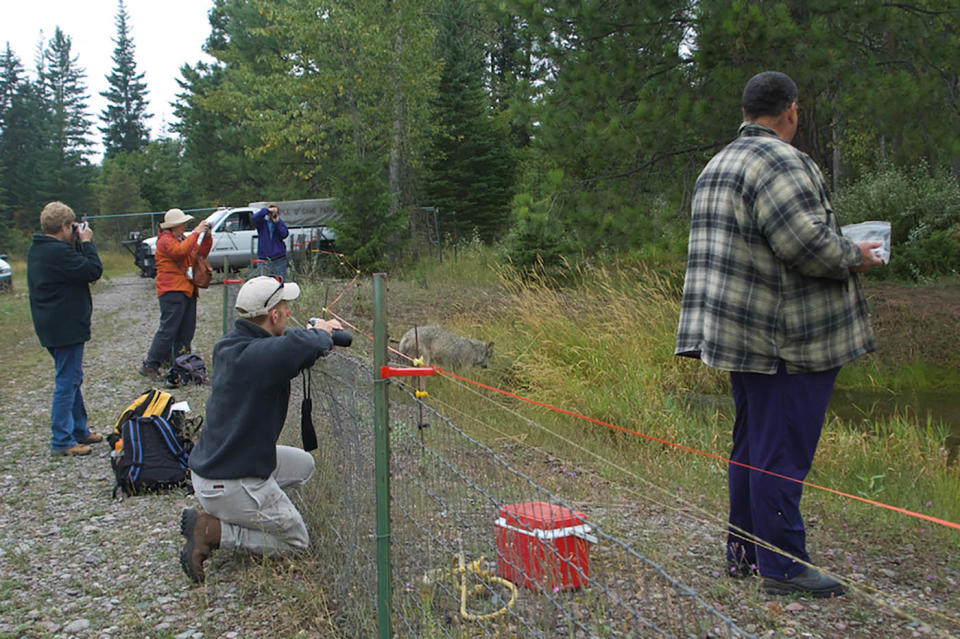
She says people would sometimes ask questions about where this wolf or that tiger lived and whether they got outside enough, but she says she deflected them because she didn’t want to lie. There were a lot of animals with illnesses that could have been prevented with swift veterinary care, she says, but “it’s cheaper to buy a baby than to pay for the vet bills.” She secretly hoped that a USDA inspector would cite Triple D for animal-welfare violations and require some improvements. But time and time again, the inspector reported: “No noncompliant items identified during this inspection.”
After about seven years, Keepers was growing increasingly frustrated, but she was hanging on to the belief that she might have a chance to take over the business one day soon. She claims Deist had promised that he was going to hand her the reins in a couple of years; she was told she was even in his will. She believed in the value of photography game farms providing an experience for photographers that they wouldn’t get anywhere else. “There are people that unfortunately can’t go out into the backwoods and go trekking into the wild to capture true wildlife photography,” she says. “Who are we to say that they shouldn’t have that opportunity if done right?”
Keepers’ biggest gripes were Deist’s alleged reluctance to take sick and injured animals for veterinary care and, she claims, his fixation with breeding. Instead of mating one pair of wolves, he would breed four, she alleges. “One year, we had eight fox kits, and then other fox litters on top of that,” she says. “Foxes are hard to sell.” Sometimes she tried to help find homes for them. In May 2019, she advertised red-fox kits and coyote pups for sale on a private Facebook page for exotic-pet owners.
Groo found the advertisement and posted a screenshot with a comment: “This is the heart of the issue, that these animals are seen only as disposable commodities — no different from used cars. This mentality must end.”
Keepers defended the advertisement on behalf of Triple D. “Nothing to hide,” she responded. “If I want to sell a car, I’m going to post it on Autotrader.” She stressed that the company was operating legally and ethically.
Then Keepers grew quiet.
“I was like, ‘What happened with Heather?’ ” Groo says. “I just had the sense that she left because she couldn’t consciously stomach what she was seeing anymore.”
It would be more than a year after posting that ad that Keepers reached out to Groo and blew the whistle.
The first photography game farm in the U.S. began with a letter to Walt Disney. Lloyd Beebe, a dairy farmer, hunter, and amateur cameraman in Sequim, Washington, had a dream: “Someday, I hope that I can stop milking cows and spend all of my time out in the wilderness shooting animals with a camera,” he told a friend. He knew Disney was starting a TV show called True-Life Adventures, and he wrote to the Disney company hoping that his films might be a fit.
Beebe was a cougar bounty hunter — in one year alone, he killed 33 of the big cats. He also kept one as a pet in his home. His first short film, The Little Archer, in 1949, starred his four-year-old son Melvin alongside the cougar and two other wild animals that he’d tamed, a deer and a bear cub. The Disney folks liked Beebe’s footage, and they soon began hiring him to film animals on movie locations and at his 80-plus-acre Washington farm.
As Beebe’s success grew, his homestead became known as “Walt Disney’s Wild Animal Ranch.” In his book, Beebe writes about the secret to taming the animals that he trapped in the woods and getting them to perform: habituation and food rewards. As one of the animal handlers working on Disney’s 1958 Oscar-winning True-Life Adventure White Wilderness, Beebe trained a pair of wild wolverines captured by Canadian park rangers to lick raw eggs from his fingers, and he slept next to them at night.
Some other stories about how animals starring in White Wilderness were treated, however, are not so tender. The film became the poster production for the mistreatment of animals. In 1982, the Canadian Broadcasting Company aired a special titled Cruel Camera, showing a clip from White Wilderness in which a polar bear cub dramatically tumbles from a steep icy incline, somersaulting over and over down the slope until it crashes into a pile of boulders. In another sequence, the filmmakers re-created a myth about how wild lemmings “commit suicide” by jumping off cliffs. A former White Wilderness cameraman told the CBC that wild lemmings were caught by children in Churchill, Manitoba, and shipped to the movie set in Calgary, where they were pitched off a rocky ledge into the “Arctic Ocean,” which was actually the Bow River running through town. The lemmings all drowned. When CBC interviewed Walt Disney’s nephew Roy, who produced the True-Life Adventures series during his era, Disney expressed remorse that animals had died. He also said, “We lost a few lemmings, OK. The lemmings probably would have gotten lost anyway.”
As a handful of outspoken Hollywood actors and advocacy groups protested the entertainment industry’s inhumane treatment of animals in the 1980s and the 1990s, photographers and filmmakers flocked to photography game farms. The most popular among them were Minnesota Wildlife Connections in Sandstone, Minnesota, Animals of Montana in Bozeman, and Triple D.
In 1993, Nat Geo WILD host and executive producer Casey Anderson was an 18-year-old animal trainer at Animals of Montana. He was amazed to be rubbing shoulders with “some of the biggest names in wildlife photography,” he tells me.
He also remembers witnessing the “dirty work” behind the camera scenes. For one, the “ugliness of the business” breeding the animals for babies, a magnet for photography clients. But only a few babies from each litter starred in the photo shoots, he says — the extras would often mysteriously disappear. “We never asked questions,” he says. “It was one of those things, like ‘Where’s the baby fox?’ We knew, but we didn’t want to know.” Then one day, Anderson says, he witnessed something he’ll never forget. “There was this older mountain lion male named Seymour that didn’t want to work, and he was there just to mate with females,” he says. He remembers the day when, he says, Animals of Montana owner Troy Hyde “shot Seymour in the head.” Later, as Anderson and another employee numbly put Seymour in the back of his truck, he thought, “ ‘What the fuck?’ We loved that animal. We’d taken care of him. He was one of our friends.”
This was the “economics” of the business, Anderson says. “He can’t feed all these animals. They’re not making money, earning their keep. But you still every year have that need for babies —everybody wants babies. So you’ve got to continue the mating game. It’s a big reason I stopped working there. I just couldn’t do it. You can’t love animals and be a part of something like that.”
In response to these accusations, Hyde says Anderson was a “disgruntled employee,” who “lives in a big glass house and he’s throwing a lot of boulders.” He says he has never shot his animals, including Seymour, who he maintains was euthanized by a veterinarian because he was 11 years old and suffering from dementia.
Hyde, who once talked to a news reporter about sharing spaghetti dinners and watching football with his grizzly bear Adam, has spent a lifetime working with animals, sometimes illegally. In 2005, he was convicted as a member of a multistate wildlife-trafficking ring buying and selling endangered tigers. His license was suspended for two years, but animal-rights activists say he should have lost it forever.
In 2012, two grizzly bears at Hyde’s ranch on the outskirts of Bozeman mauled to death a 24-year-old employee named Benjamin Cloutier, who was cleaning cages. One of the bears had to be shot to recover Cloutier’s body. An investigation into the incident found a previous unreported injury to an employee whose skull was lacerated by a mountain lion, and numerous undocumented animal escapes. Hyde says he has no response to that accusation.
“If he hadn’t gotten his license back, Benjamin Cloutier would probably still be alive today,” says Brittany Peet, an attorney with the nonprofit People for the Ethical Treatment of Animals Foundation (PETA).
For his part, Hyde says, “That’s bullshit.”
Still, Hyde paid a $9,000 fine for safety violations and settled a wrongful death lawsuit with Cloutier’s family — but Animals of Montana continued to operate. In 2015, one of Hyde’s tigers got loose on a photo shoot with photographer David Yarrow in the historic Packard Plant in Detroit. A video of the incident surfaced on social media, showing a man at the scene trying to corral the tiger huddled on a fourth-story staircase using a blue tarp and a weed wacker.
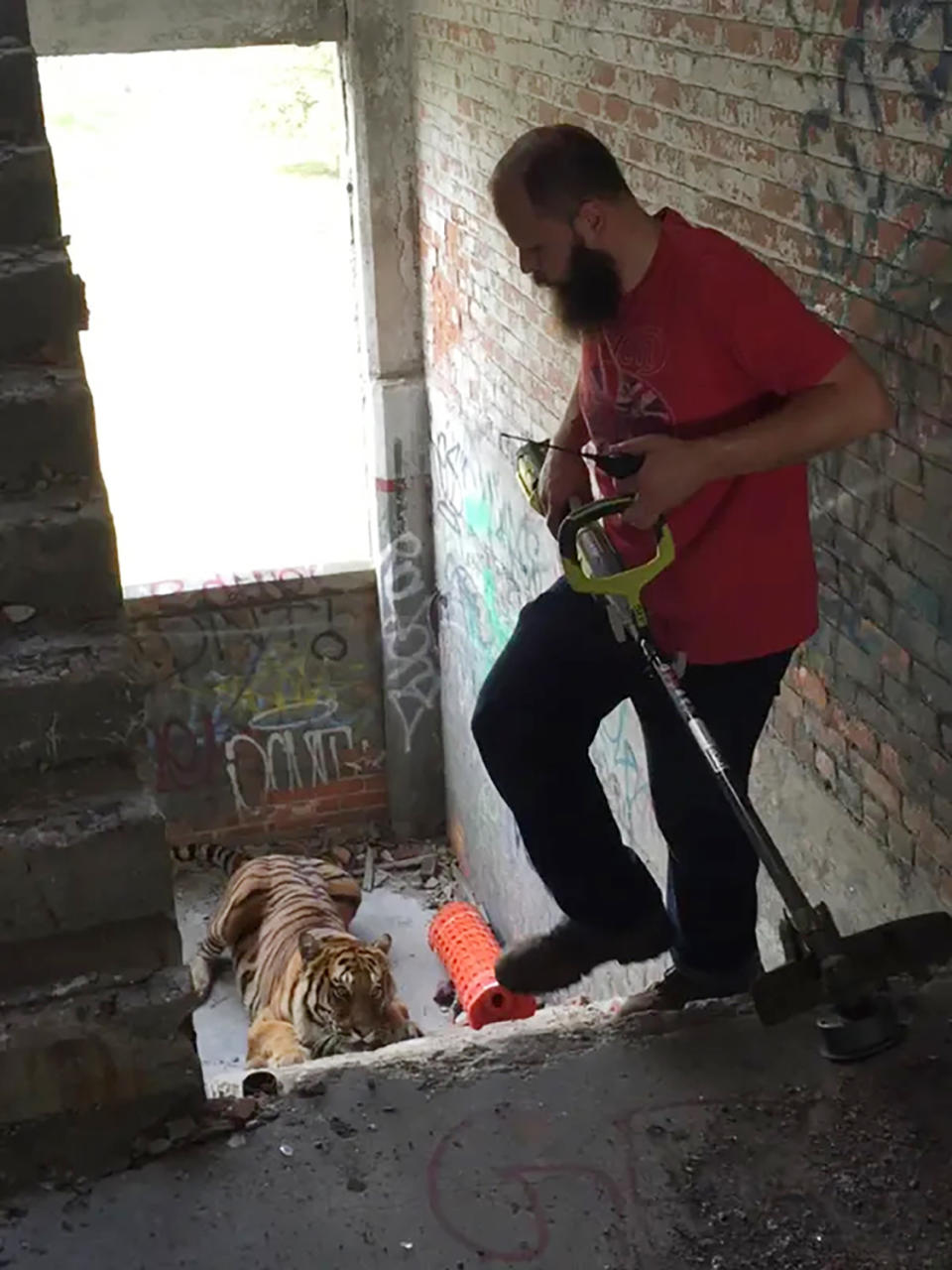
When I ask Yarrow about what happened, he denies that the tiger ever got loose. “It just fell asleep,” he tells me. “It was just sleeping, and there was someone on set who, for whatever reason, wanted to make a story out of it.” Hyde likewise denies that the tiger was out of his control.
Montana revoked Hyde’s license in 2017, and the U.S. Department of Agriculture, the agency that oversees the care of exotic animals and exhibitor authorizations, terminated his federal license last October. In April, PETA filed a complaint to the USDA alleging that Hyde used the alias “Tom” to advertise wolves and a lynx on exoticanimalsforsale.net, a website for eccentric pet buyers, without an animal license as recently as December 2023. Hyde denied the accusations and says he’s out of the entertainment business. He claims that he no longer has any animals, including as of March the bear Adam. “I had him euthanized by a veterinarian,” Hyde says, at 24 years old. “He got to a point where he couldn’t get up no more. His back legs failed him. He was starting to drag himself around. I’ve always been a firm believer of letting them go with dignity.”
Hyde’s bad-boy rival in the photography game-farm industry is Lee Marvin Greenly, 63, a twice-convicted felon and owner of Minnesota Wildlife Connection, which operated illegally for years after his license was revoked for animal-welfare violations. Greenly’s most infamous stunt was a plan to make country-music singer Troy Gentry look like a badass bear hunter. (Gentry died in a 2017 helicopter accident.) Back in 2004, Greenly’s tame bear Cubbie needed some dental work, but instead of fixing the bear’s teeth, he sold a canned hunt to Gentry for $4,650. In a video broadcast on the internet, Gentry smiles at the camera from his tree stand, watching Cubbie, oblivious, ambling into his fenced woodland enclosure. Then Gentry aims and shoots Cubbie with an arrow, fatally wounding the bear. Cubbie tries to get away, but Gentry shoots another arrow. Then he gives a big thumbs-up to the camera. “Wow, what an experience,” Gentry feigns, breathing hard. “This is awesome. Great black bear hunting up here in north Minnesota with Lee Greenly. I’ll get you hooked up.”
A dead wolf was Keepers’ breaking point. On the morning of May 11, 2020, she discovered that Cila, a nine-year-old wolf that she’d raised from birth, had been mauled to death in her cage by an Arctic wolf that was newly arrived from Europe. Keepers was livid that Deist appeared to blame her for the incident because she was the person who put the wolves together. She challenged him, saying he had approved the plan. She remembers him arguing and telling her to “shut your fucking mouth,” and to get off the property.
Keepers didn’t go to work for a couple of days; she says Deist wanted to talk things over, but she would only agree if she could record the conversation, a tape of which she later shared with me. “You told me to leave,” Keepers charged. “And I said, ‘You want me to leave?’ And you said, ‘I’ll leave it up to you.’ And then the final comment: ‘You can leave, we’ll make other plans for the business. I don’t need you.’ ”
Deist told her that they’d been like family — and families fight sometimes. He couldn’t remember what he said, but he was sorry and he wanted to reconcile. Clients were arriving in the morning —they needed Keepers to be there.
She reluctantly agreed to go back to work the next day, but she’d come to the conclusion that the Deists never intended for her to take over the business. She says she asked them if they would let her fundraise to build some bigger enclosures for the animals. They agreed to consider it, she says, but then told her that they didn’t want charity. Deist offered an area where they could build some new enclosures, Keepers says, but in her opinion, the plan was “jerry-rigged.”
That was when she began focusing on a new mission: going public with what she knew went on behind the scenes at Triple D.
Keepers started documenting everything in pictures and videos — animal enclosures, veterinary and business records, emails about animal purchases — and preparing her colleagues, Justine Hayes and Jenny Kirk, to take over the animal training when she left.
Hayes and Kirk knew they were in for a rough transition. Keepers had strong bonds with most of the animals — she raised many of them — and big, dangerous cats, wolves, and bears often don’t adapt well to change. If the animals didn’t work well with their new trainers, they would be useless for photo shoots, and therefore stuck in their cages, or sold elsewhere.
“When I made the decision to leave, it was the hardest thing I’ve ever done,” Keepers tells me. “It’s like walking away from your kids.” But she was committed to it because she felt that she had to do something.
On July 8, 2020, Keepers hugged and kissed the animals goodbye and left Triple D for good. The Deists told clients that she left to be with a boyfriend — it was for personal reasons that had nothing to do with them.
In the aftermath, the vibe at Triple D was “frantic,” says Kirk, describing how the Deists didn’t seem to know what to do next. Hayes was promoted to head trainer, and their jobs working with large predators suddenly felt even more dangerous. “There were a lot of situations that Justine and I got put into that we didn’t feel comfortable doing,” Kirk says, “but felt like we had to.” One particular mountain lion named Dee Dee did not want to work with them. “There were a few times when [Dee Dee] got this crazy look in her eye,” Kirk says. “Justine and I would look at each other like ‘This might be it.’ ”
Kirk says they told Deist that they were feeling unsafe. She tells me how in the Back 40 the enclosures didn’t seem secure. “Animals could reach their paws through and grab you while you were feeding them,” she recalls.
They also shared their concerns and fears with Keepers. Before long, they joined her crusade against Triple D. All three women had signed nondisclosure agreements when they took their jobs, but figured that the cost of breaking those contracts would be worth it if they could shut down Triple D. What’s more, the three women started working closely with a filmmaker who is creating a documentary about game-farm photography.
Keepers warned the U.S. Fish and Wildlife Service (FWS) that they believed Deist was planning to illegally purchase a pair of endangered snow-leopard kittens from a seller in Minnesota. Similar activity — unlawfully purchasing protected lion cubs — landed Tiger King star “Doc” Antle a suspended two-year prison sentence and a $10,000 fine.
The USDA is failing to protect animals at the facilities it’s supposed to regulate, even when inspectors document suffering and death.
They felt somewhat vindicated in June 2021, when a USDA veterinary medical officer accompanied the agent who had been doing Triple D’s animal-welfare inspections. After years of flawless evaluations from that agent, Triple D received a 42-page report detailing serious animal-welfare violations, including confining animals in unsafe and unsanitary enclosures filled with feces, rotting food, and unclean water receptacles. “Many of these receptacles have a green coating on the interior surface in contact with the water, and some of the water receptacles have dead flies and floating debris,” the officer wrote. Surveying an area where smaller animals are caged, she noted, “There is an excessive accumulation and buildup of dirt, grime, fur, and urine on shift doors and enclosure walls.”
A spokesperson for the USDA’s Animal and Plant Health Inspection Service said he could not answer questions about the inspector or Triple D. “We don’t expand beyond what is already included in our inspection reports,” he writes, providing a statement that the agency works with facilities to ensure compliance with Animal Welfare Act regulations. When issues arise, the statement says, “we work hard to bring them back into compliance as quickly as possible.”
Deist was given the opportunity to correct the problems without penalty.
When Groo found out about the report, she posted an article on Facebook headlined “Photography game farm Triple D Wildlife cited 6 times for keeping animals in squalor” with a comment: “More on Triple D photo game farm. What a disgrace to treat these magnificent animals so poorly. It’s time for these wildlife brothels to be done.” She also implored photographers and artists planning to hold workshops at Triple D to cancel them. “It would be unconscionable to continue to support this facility,” she wrote, tagging some of the people leading workshops there.
Deist’s attorney sent a letter to the company’s clients stating that “disgruntled” former employees and associates were trying to destroy Triple D’s good name with false and malicious accusations. These malcontents and their baseless complaints to the USDA had triggered a two-day inspection, the letter explained. After which, “the lead inspector commended the staff on the high quality of animal care and stated the health and condition of Triple D Wildlife was ‘one of the best’ she had seen in the industry.”
Vermont law professor Delcianna Winders said that even though the department’s documented findings were very critical of the conditions at Triple D, it’s rare that anything is ever done to properly enforce even basic animal-welfare standards. “The USDA is, without a doubt, failing to protect animals at the facilities it is supposed to regulate,” she says. “Even when the agency’s own inspectors document egregious violations involving suffering and even death, the agency fails to take meaningful action. On top of that, it continues to renew the facilities’ licenses to exhibit animals.”
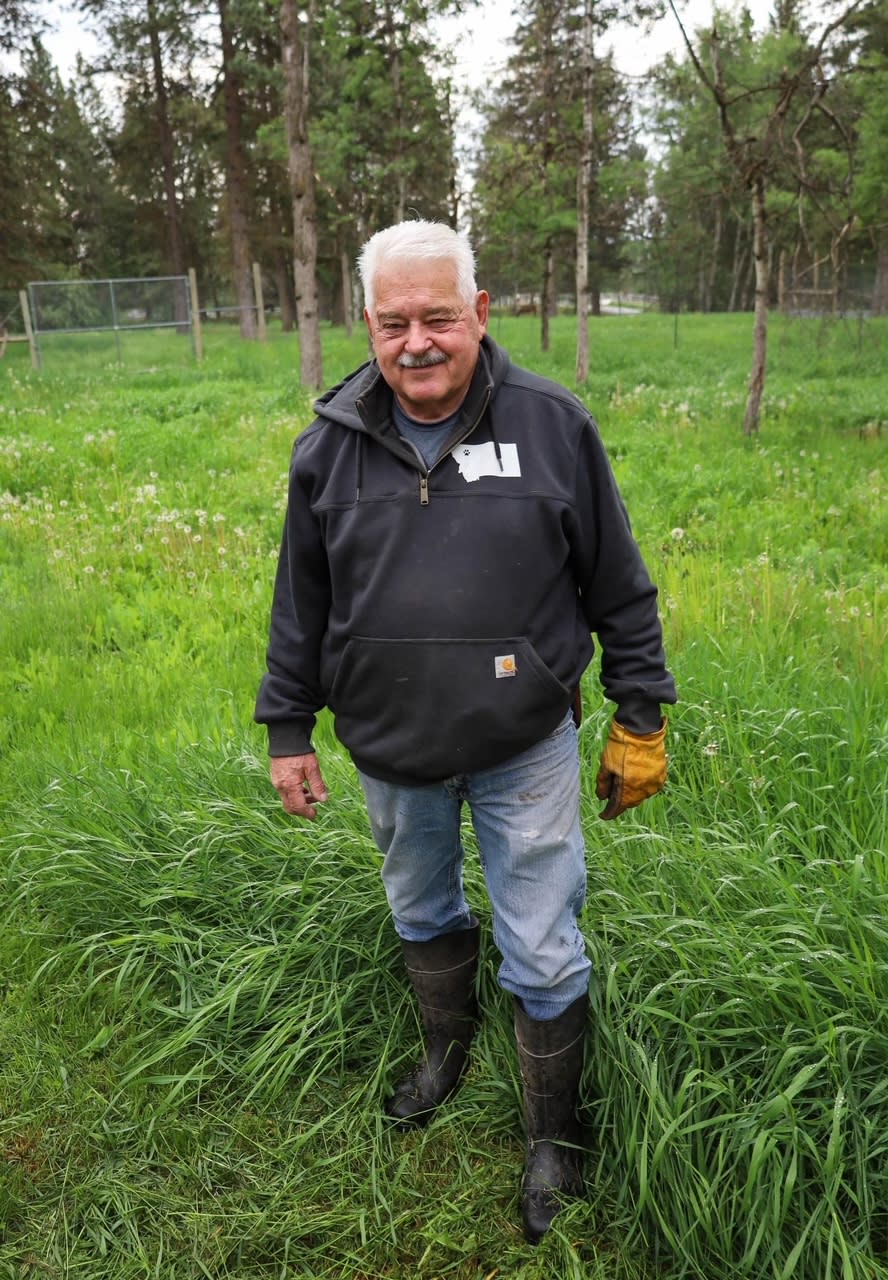
Jay Deist is no stranger to the courts. After he divorced his first wife, Cynthia, in 1996, he fought to avoid paying out-of-pocket orthodontics treatments and contact lenses for one of their daughters. While he was still employed by the Forest Service, he battled with a whistleblower at a logging company who said he’d threatened her. The court sided with Deist, who then sued her for damaging his reputation. He won.
Deist wasn’t going to let these four women smear his name and destroy his business. He filed lawsuits against Keepers, Hayes, and Kirk, charging that they violated their nondisclosure agreements and interfered with his company, costing him at least $100,000 in lost revenue. In a connected lawsuit against Groo, he accused her of running a harmful social media campaign against his business.
Groo filed a motion for the Montana District Court to dismiss the suit on the basis that Montana has no jurisdiction over what she, a resident of Ithaca, New York, writes on the internet. But the court upheld the ruling. In March 2023, the case was considered by the Montana Supreme Court, where one justice raised the question at the heart of the case:
What is the difference between Groo’s Facebook comment and a review of a business published online? The answer, according to the Montana Supreme Court’s 4-3 ruling last October, is that Groo intentionally tagged people in Montana, and as a result, clients canceled contracts with Triple D.
Groo appealed to the U.S. Supreme Court, which rejected her case in March of this year. The lawsuits against Groo and the others can now move forward. In the employees’ cases, their defense may be aided by whistleblower protections, according to Siri Nelson, executive director of the nonprofit National Whistleblower Center, because they were “conscientious insiders,” trying to raise concerns that were not being welcomed or heeded.
In the meantime, some of the animal-welfare accusations made against Deist have also been alleged by the USDA. In November 2023, the agency filed a complaint against Triple D documenting multiple instances in which animals reportedly escaped from the facility and either died or were never recovered, and animal injuries and deaths that happened on the property. The allegations include the incident in which Cila the Arctic wolf was mauled to death and an episode in which a snow leopard lost two thirds of its tail in an attack by another leopard.
Yet less than six months prior to the USDA’s complaint, the agency reported an initial inspection of a seemingly new facility called Rivers Edge LLC at the same address as Triple D. According to Keepers, the animals listed on the Rivers Edge inspection report are the same species that live in cramped cages on “the Back 40,” tucked into cottonwoods and pines along the Whitefish River, out of sight from visitors.
“How in one breath can USDA bring this level of complaint against them all while going through the process and approving them for the same permits under a new name?” she says, frustrated. “I have no faith in this system.”
In October, Lorney Deist (Jay’s real name) advertised on exoticanimalsforsale.net that Rivers Edge was taking orders for 2024 babies, including badgers, otters, foxes, lynx, wolves, and bobcats.
When animal-welfare lawyer Winders examines the Rivers Edge license and inspection report, she tells me, “It appears that Jay is trying to hide behind this new business name. Notably the Animal Welfare Act regulations prohibit holding more than one license. Unfortunately, it is not unusual for those facing enforcement to try to illegally hide behind other licenses.” She says that if the USDA revokes Triple D’s license, “it will be illegal for Deist to engage in any Animal Welfare Act-regulated activities — exhibiting animals, dealing animals, etc. — ever, under any name.”
Welfare groups are paying close attention to Deist’s animal sales. Government documents show that last May, Deist attempted to sell Hershey, a tiger, and a black bear named Casey to a private collector in Texas. “Tigers are endangered,” says PETA’s Brittany Peet. “If that was in fact a sale — and it was marked as a sale — that would be illegal trafficking of an endangered species.”
Her group has submitted a complaint to the FWS, which would not comment about the status of the inquiry. “If the U.S. Fish and Wildlife Service is able to substantiate that and they charge him for it, it would be a pretty big deal,” Peet says. “Those are serious charges.”
It’s unclear what happened with the sale to the private collector, but it seems to have fallen through. Two months later, according to public records, Deist transferred ownership of Hershey to the Exotic Feline Rescue Center in Center Point, Indiana, where more than 100 big cats and other animals live on 260 acres. The center provides homes for exotic pets and retired circus animals that have been abandoned, abused, or are in need of a permanent place to live. According to the center’s policies, it does not buy, sell, or breed animals or allow the public to have contact with them. The center also recently received a snow leopard, mountain lion, and two wolves from Triple D.
On a sunny, warm morning when Keepers has a day off from her current job at the Louisville Slugger Hitting Science Center, she meets me at a Starbucks in La Grange, Kentucky. She’s fresh from a half-hour HIIT exercise class, wearing yoga pants and a white tank top that says “If you’re reading this, I hope something good happens to you today.”
I climb into the passenger seat of her green SUV, where the car’s ceiling console is decorated with a handful of wiry tiger whiskers collected during years of cleaning the big cats’ cages. A long pheasant feather fans across the dash, and a leopard pendant necklace dangles from the rearview mirror.
She drives for three hours to the Exotic Feline Rescue Center. There, in a gravel parking lot, she quickly changes into jeans and a black hoodie, and then grabs a package of raw chicken wings from her trunk.
As we approach Hershey’s large enclosure, the tiger recognizes Keepers, loudly chuffing — a tiger’s version of a purr — moaning, and rubbing against the fencing. Keepers squats to scratch the big cat, and speaks sweetly to her through the grate. “She’s always been very chatty,” she tells me, offering the tiger a couple of chicken wings. “She was only a week old when we got her. They told us that we had a boy, but the health certificate said she was a girl. I was like, ‘Nope, I think we got a Her-she, not a He-she.’ That’s how she got her name.”
She tells the tiger to “sit,” and the big cat quickly sits. “Good girl! What a good girl,” Keepers says, as Hershey happily crunches on the wing bones. “Good job, big kitty. Good girl. What a good sit. I love you.”
Keepers stays for a couple of hours, delivering chicken wings to Aryaa, the snow leopard, and the wolves, Roman and Ryggs. She hates to leave. “It’s always hard to say goodbye,” she tells me later. “But it’s easier knowing where they’re at and that they have each other. I know they’re cared for.”
Even in the face of the lawsuit, she’s glad that she is speaking out about Triple D. “Most people who go there are avid animal lovers and think they’re supporting something that’s giving back to wildlife and conservation,” she says. “Most people would be mortified at what they’re supporting if they actually knew the truth. They deserve to know.”
Best of Rolling Stone

